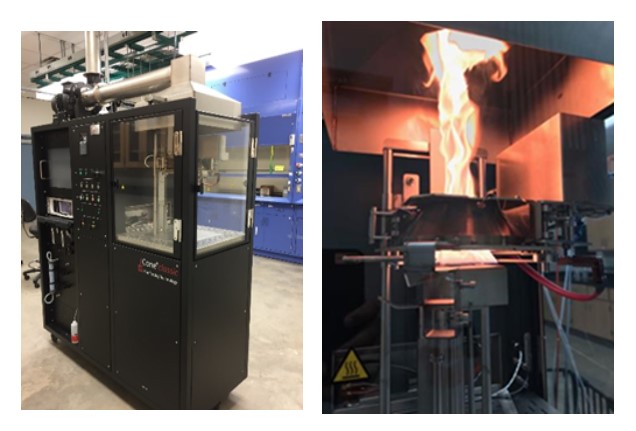TAMU Fire Testing and Flame Retardant Capabilities
Background
Fire has long been a major hazard in our lives. According to the NFPA 2011 statistics data, 35% of the fires that occurred in the US were structure fires, of which 84% were homes. Polymeric materials have been used almost everywhere in buildings, manufacturing, and chemical processes but most of these materials are highly combustible. When it is used as films, coatings and foams, those thin objects are even more combustible than bulk materials. To control those polymeric fires, flame retardant technology is becoming increasingly important.
Research Objective
To develop non-toxic flame retardant plastics via low-cost and scalable manufacturing processes.
Research Method
In general, flame retardant additives are incorporated in the polymer matrix to increase the time to ignition, improve self-extinguishing properties, decrease the heat release rate and prevent the formation of flammable drops. We are developing novel 1-D and 2-D materials as effective flame retardant fillers. Flame retardants can be synthesized/manufactured by using three methods in our lab: in-situ polymerization, twin screw extrusion and homogeneous solution. Flame retardancy can be tested by using existing FTT equipment in the lab: cone calorimeter (ASTM E1354), FAA micro combustion calorimeter (ASTM D7309), limiting oxygen index (ASTM D2863) and UL 94 (ASTM D635, D3801).
We have established a unique world-class laboratory which has the capability of fundamental studies on flame retardant materials design, synthesis and characterization, comprehensive fire testing, composite manufacturing and scale-up, as well as their novel applications in the energy industries. For more information on how we can help you develop flame retardant technology and solve complex issues in materials flammability, contact Dr. Wang at 979-845-9803 or qwang@tamu.edu.
Selected Publications
Metal–Organic Framework as an Efficient Synergist for Intumescent Flame Retardants against Highly Flammable Polypropylene, Industrial & Engineering Chemistry Research, 2022, DOI: 10.1021/acs.iecr.2c00715.
A review on cone calorimeter for assessment of flame-retarded polymer composites, Journal of Thermal Analysis and Calorimetry 2022, https://doi.org/10.1007/s10973-022-11279-7.
Fire reaction properties of polystyrene-based nanocomposites using nanosilica and nanoclay as additives in cone calorimeter test, Journal of Thermal Analysis and Calorimetry 2018, 132(3), 1853-1865. DOI: 10.1007/s10973-018-7127-9
Cone calorimeter analysis of flame retardant poly (methyl methacrylate)-silica nanocomposites, Journal of Thermal Analysis and Calorimetry 2017, 128 (3), 1443-1451. DOI: 10.1007/s10973-016-6070-x
Effect of trimethylolpropane triacrylate cross-linkages on the thermal stability and char yield of poly (methyl methacrylate) nanocomposites, Fire Safety Journal 2017, 87, 65-70. DOI: 10.1016/j.firesaf.2016.12.004
Thermal degradation and flammability of nanocomposites composed of silica cross-linked to poly(methyl methacrylate), Plastics, Rubber and Composites: Macromolecular Engineering 2016, 45 (9), 375-381. DOI: 10.1080/14658011.2016.1204773

